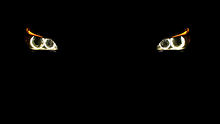Parking light rings


Under parking light , AngelEyes or corona rings is meant annular plastic light guide rods in the (clear glass) headlights of a car, which surround each individual reflectors annular and form a sort of ring of light. When switched on, they achieve what is known in the trade press as an “eye effect”. The light from a 10 watt incandescent lamp is introduced into the light guide rods; LEDs are currently predominantly used. They serve as position or parking lights and are intended as a side effect to accentuate the front of the vehicle.
The idea and technology for these light rings (Celis technology) come from the automotive supplier Hella . The Italian designer Leonardo Fioravanti claims to have developed this lighting concept before Hella. Initially, parking light rings were introduced as standard at BMW . The 5-series ( BMW E39 ) was the first to be equipped with it as part of its visual revision. BMW has meanwhile developed the parking light rings so that they can also function as daytime running lights due to their high luminosity .
Retrofitting
This new type of lighting met with great interest, so that retrofit solutions were also developed. Hella expanded the range of headlights with integrated parking light rings and there are conversion kits for various other BMW models, such as the E36 , and also for some Volkswagen models, such as the VW Golf III and VW Golf IV . These are based on the same lighting technology as the light rings that were first used in series in September 2000.
Today, front lights with parking light rings are available as retrofit kits from various manufacturers for the most common car models. Attention must be paid to approval according to StVZO , which is not granted for some models due to the lack of headlight range adjustment. The headlights may only be operated with approved lamps.